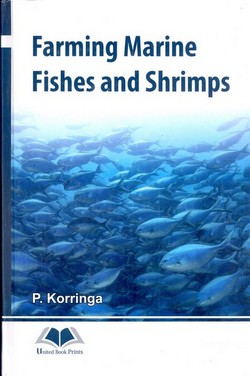k.p 639.5

Farming Marine Fishes and Shrimps
A Multidisciplinary Treatise
By
P. Korringa
Introduction
Herbivores promise an interesting production level because of their short food chain: they feed directly on the organisms of the primary production. Unfortunately there are about few Herbivorous species of fish in the marine environment suited to farming. The most important of these is no doubt the milkfish (chanos chanos), which reproduces in offshore, high salinity water, but can be raised in water of an extremely wide range of salinities. Ponds constructed in the mangrove swamps fringing the coasts of several tropical countries can be used to advantage for milkfish farming. But it is also possible to raise this fish further inland, in water of low salinity, provided its favorite food – blue green algae – is amply available. One glance at maps of countries like Indonesia and the Philippines shows that it must be possible to expand the milkfish industry considerably, for there are vast stretches of mangrove swamps which are at present not used at all, but which would be suitable for fish farming. There are, however, some constraints which hamper rapid expansion of this industry. Of course there is the need for skilled farmers, but the present training centres can see to this, if required, at an accelerated pace. Further, one should find markets of reasonable size in the neighbourhood. Markets which can absorb the farmed fish at a good price, for milkfish is by preference bought in the fresh state, though palatable preserves can be made of it. The main bottle-neck is. However, that it is often difficult to collect or to buy all the fry one needs for stocking the ponds. In several areas it becomes increasingly difficult to purchase fry in the desired quantities. One now explores fry catching areas further away, and even uses planes to transport the fry. The reasons for this scarcity are imperfectly known. Expansion of milkfish farming is to be expected from the moment it is learned how to breed this fish under controlled conditions, but that moment seems still quite far away.
Milkfish farming is not only interesting for the amount of animal protein it brings on the market, and that in no way in competition with the existing fishing industry, for milkfish is hardly caught at all in the sea, but also to provide a living for the farmers, operating on family basis. The experience is that it is economically sound to bring the milkfish to the market long before it is fully grown. One can use the ponds most efficiently by keeping the fish in them for one season only. The conversion rate from blue-green algae to fish flesh is better in the younger fish than in the older ones. In some countries one not only adds fertilizer to the ponds to stimulate the development of blue-green algae, but also administers extra food, mostly in the form of pellets, to the fish. Thus the production per acre can be increased but this not on the basis of the primary production in the pond itself. One comes then, close to a real bio-industry, in which the fertility and productivity of the site of farming no longer plays an important part. Production figures for such a situation must therefore be considered with caution, since the economy of such a system is quite different from that of farms based on local primary production.
Contents
Chapter 1 : Mullet Farming in Israel
Chapter 2 : "Vallicultura" : mullet farming on the Adriatic coast of northern Italy
Chapter 3 : Farming the milkfish (chanos chanos) in Indonesia
Chapter 4 : Farming Penaeid shrimps in Japan
Chapter 5 : Eel farming in Japan
Chapter 6 : Farming the yellow-tail (Seriola quinqueradiata) in Japan
Chapter 7 : Farming the Red Sea bream (chrysophrys major) in Japan
Chapter 8 : Farming rainbow-trout and salmon in marine environment in Norway



ساحة النقاش